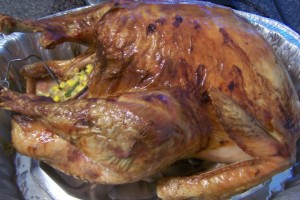A couple of years ago, I made my first turkey. I was soo nervous, I was even dreaming about the turkey. What if it didn’t turn out right, what if it was too dry, etc. etc.? But, it turned out great, and I am a big fan of “IF IT AINT BROKE, DON’T FIX IT”. So here is the tried and true recipe I found here for a Yummy Juicy Turkey!!
Roasting Tips for a Moist and Tasty Turkey
There are many methods used to cook a moist and tasty Roasted Turkey. Most methods rely on basting. The turkey can be basted every 30 minutes with a basting bulb, or covered with cheesecloth soaked in butter. Other methods include brining the turkey (soaking in a salt water solution for 8-10 hours), or injecting a basting solution into the meat. Whatever method you prefer, proper roasting is key to tender moist meat.
** Personal Note: As my basting sauce, I used one stick of butter, rosemary, cracked black pepper, chicken broth, sage, and thyme.
Completely thaw the turkey. Start early and thaw the turkey in the refrigerator or in a place where the air temperature is no higher than 40 degrees. A 20-pound turkey takes about two or three days to thaw completely. Be sure the turkey is thawed completely, until no ice appears in the inner cavity and the meat is soft. Be careful: If the inner cavity is still frozen or even partially frozen when you put the turkey in the oven, the outside of the bird will be done before the inside, and the inside temperature will not be hot enough to destroy disease causing bacteria, or if it is, the outside meat will be dried out before the center is done.
Remove the neck and giblets from the cavities. If this is your first time cooking the turkey, be sure that both cavities are emptied. Reserve the neck and giblets for use in preparing the giblet gravy, if desired.
Prepare the stuffing. If you are preparing the stuffing early, mix only the dry ingredients. It is recommended that you cook the stuffing separately, but if you do stuff the turkey, do not stuff it until you are ready to roast it. Stuff the cavity loosely. Do not pack it. If you choose to cook the stuffing separately, you can place a quartered onion and some celery leave and other desired herbs in the cavity for flavor.
Prepare a basting sauce. I prefer to baste with melted butter to which I add fresh or dried herbs. You can also baste with a mixture of wine and butter. Baste the turkey with your sauce and place a loose tent of aluminum foil over the turkey to prevent the skin from burning before the turkey is cooked. This tent will be removed during the last 45 minutes or so of cooking. If you are using cheesecloth, soak the cheesecloth with the basting sauce and place over the breast and drape onto the thighs. When using cheesecloth, you do not need the foil tent. Baste the turkey every 30 minutes during roasting.
Roast your turkey at 325 degrees for the recommended time for the weight of your turkey. These times are approximate and should be confirmed with a meat thermometer. Be sure to check the thermometer about 3/4th of the way through the time indicated so as not to overcook. Dry meat will result if the turkey is overcooked. The following table gives approximate times for roasting turkey at 325 degrees F.
Estimated Cooking Times
Wt. of Turkey Unstuffed Stuffed
10-18 lbs 3- 3 1/2 hrs. 4 – 4 1/2 hrs
18-22 lbs 3 1/2 – 4 hrs 4 1/2 – 5 hrs.
22-24 lbs 4- 4 1/2 hrs 5 – 5 1/2 hrs
24-29 lbs 4 1/2- 5 hrs 5 1/2 – 6 1/2 hrs
The turkey must be roasted all at once. You cannot partially cook it ahead for later finishing. This method has been shown to increase the chances of food borne illnesses.
For safety and doneness the internal temperature must reach 180 degrees F in the thigh and 170 in the center of the breast. If the turkey is stuffed, the stuffing should reach 165 degrees F in the cavity. This temperature is essential to prevent food borne disease, and should be measured with a meat thermometer. The pop-up thermometer that comes in many turkeys serves as a good approximate of doneness, but should not be relied on as the ultimate authority. When placing the meat thermometer in the thigh or breast, it is important not to touch the bone. The bone conducts heat and will be hotter than the meat. Do not allow the cooked meat to come into contact with anything that has touched the raw turkey.
During the last 30 – 45 minutes of cooking, remove the foil tent to encourage browning. If you desire to use a glaze, spread it over the turkey now with a pastry brush.

Pulling off your first Holiday Meal, is a right of passage. It can definitely be stressful, but it can also be very fulfilling. Good Luck!!



